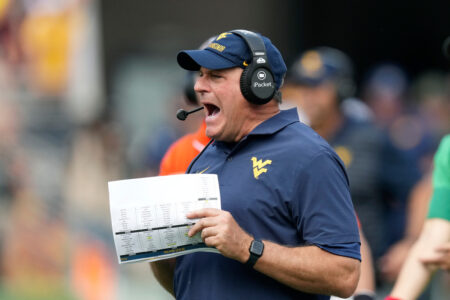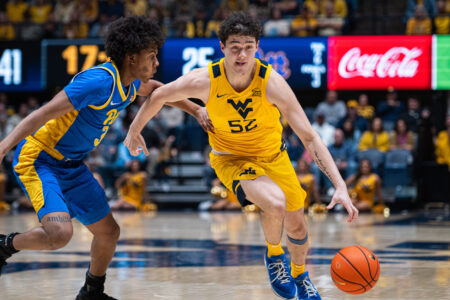Rich Rodriguez In Favor Of Adding NIL Limitations In College Football

West Virginia head coach Rich Rodriguez shouts to his players during the second half of an NCAA college football game against Arizona State Saturday, Nov. 15, 2025, in Tempe, Ariz. (AP Photo/Ross D. Franklin)
The introduction of NIL five years ago has made college football similar to the wild, wild west. There aren’t a lot of rules.
Teams have taken advantage of the nonexistent guardrails and are dishing out wads of cash to pay players to compete for championships. Pair that with the transfer portal, schools can buy whoever they want.
The duo of NIL and the transfer portal has seen immediate success. Last year, Ohio State rolled with its highly valued roster and won a National Championship. This year, West Virginia’s opponent on Saturday, Texas Tech, accumulated a large amount of donor money to pay its roster, creating a monstrous defensive line.
The Red Raiders, with their expensive roster, are a top 10 team in the country and the favorite to win the Big 12. Last year, Texas Tech finished 8-5, and now this year, it sits at 10-1 with a game to go.
“There was a lot made of it before the season, and rightfully so,” Rich Rodriguez said. “When they get a Power Four transfer, maybe he was doing okay at the Power Four. These guys were dominant at the Power Four level, and they’re dominant still at the Power Four level. They picked the right guys, evaluated very well, and they’re coached well, too. It’s not just great players. They’re coached really well, and I’ve been really impressed by how hard they play all those guys. There was a lot made of it, before the season, rightfully so.”
There have been attempts to even the playing field so that college football doesn’t become the MLB, where there is no salary cap. To start, this June, a court ruled in favor of athletes, allowing schools to directly pay athletes through revenue sharing.
There was a set cap of revenue-sharing money at $20.5 million, and the College Sports Commission was created to oversee the NIL deals and create guardrails.
But that didn’t mean there was a cap on NIL. Schools, or more correctly, donors, can pay players on top of the money used through NIL. There were no boundaries, so schools like Texas Tech can still have lucrative costing rosters.
Last Wednesday, the College Sports Commission sent out an 11-page participation agreement to all Power Four schools that would create limitations on NIL and revenue sharing, shortening the gap between the rich schools and the poor.
Rodriguez is in favor of the agreement.
“I would,” Rodriguez said on signing the agreement. “I think a majority of the schools probably would. It’s kind of fair and equal across the board, like a true salary cap, like the NFL has.”
That’s easy for Rodriguez to say, though. WVU isn’t in a position to spend millions of dollars on a roster. Athletic director Wren Baker spent all summer trying to accumulate deals to reach the revenue-sharing allotment. Baker’s working on getting extra cash, but WVU is not there yet.
Schools like Texas Tech, who have money, are hesitant to sign the agreement.
“But if I’m one of those schools that have more and can do more, I can see why they’re saying, ‘Oh, we got more. Let us do more,'” Rodriguez said. “I understand where they’re coming from.”
It’s more than just buying players, though. The New York Mets and Yankees had two of the highest payrolls in baseball, and neither were even in the conference championships. The Los Angeles Dodgers spend a lot of money, but they’ve used the money wisely, which is why they’ve won back-to-back World Series.
The same goes for college, and Texas Tech, so far, has paid the right players.
“They evaluated the right guys,” Rodriguez said. “They did a great job of evaluation, first off. I don’t know what everybody on the roster is getting paid, but it seems to me that they distributed in the right way, and they’re getting their guy, all their guys played really hard.”
The rest of college football is taking notes on how Texas Tech used its money in the right places. It’s not a new idea, either. The Red Raiders saw what Ohio State did a year ago, and pretty much did the same thing. WVU will try to take as much as possible from Texas Tech after this year.
“I’m sure,” Rodriguez said. “We are. I think everybody is. You study people who are doing well. Why are you winning? Obviously, you got the right players, you got the right staff, you got the right facility. There’s usually a multitude of reasons that you have so much success.”
The Mountaineers brought in a lot of players through the transfer portal, 70-plus. Most of them were paid, and a lot of them haven’t panned out. Two quarterbacks on its roster haven’t won a game.
Charlotte quarterback transfer Max Brown hasn’t completed a pass all season. Most of WVU’s transfers have also been injured, too.
There’s a little luck when it comes to building a roster.
“You got to be fortunate, too,” Rodriguez said. “There’s always a little bit of guesswork. They got to stay healthy, too, right? Say a guy you bring in and evaluate, you hit on his evaluation, he’ll be a great player, but then he gets banged up, and he can’t play well. Maybe you did everything right, you just had bad luck. There’s always going to be some luck or some fortune involved in that as well.”
Right now, there is no salary cap on NIL or on how much a team can spend. Rodriguez might want change, but that might not happen for a while. So for now, Rodriguez is working with what he’s got and figuring out ways for WVU to close the gap.
“You can sit there and complain about it, or you can say, ‘What do we do to overcome that team, or teams that can simply buy more players more than you because they got more NIL money? I think every coach can sit and complain about it. I think the better avenue is, how do we solve that problem? Whether it’s fundraising or evaluation or what have you. Try to make sure that gap doesn’t determine wins and losses.”





